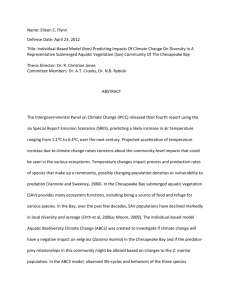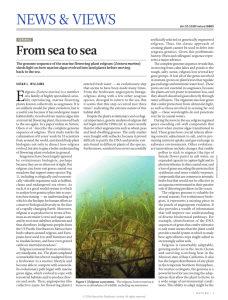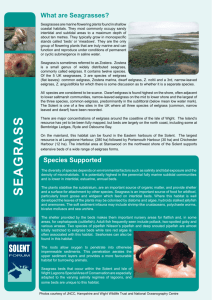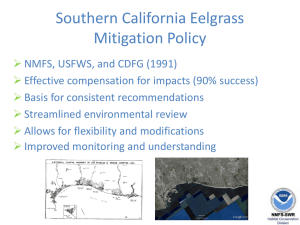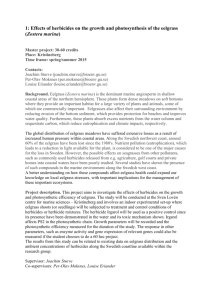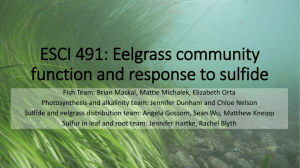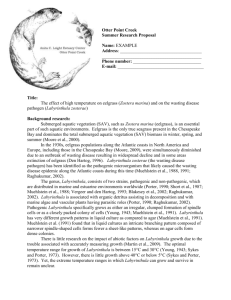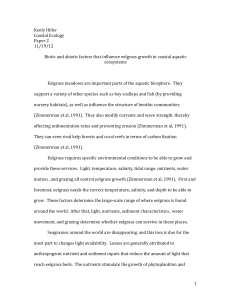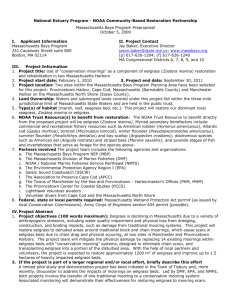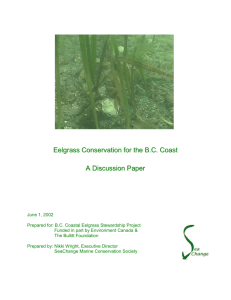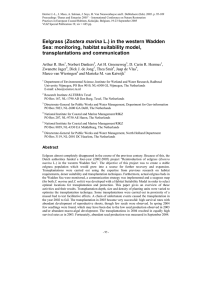HillerEelgrass - BIOEEOS660-f12
advertisement
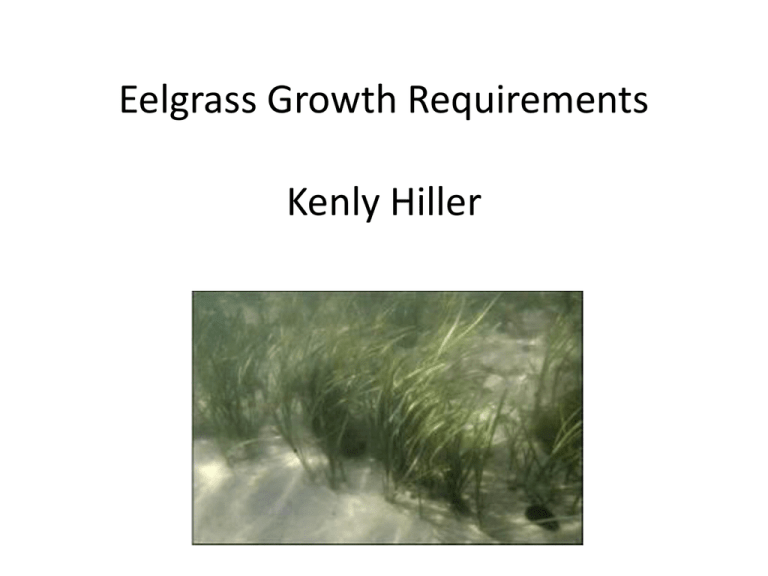
Eelgrass Growth Requirements Kenly Hiller Eelgrass is important • Supports variety of other organisms • Affect sedimentation rates by modifying currents and waves • Rival reefs in terms of C fixation Many factors influence eelgrass growth (Zimmerman et al, 1991). • • • • • Temperature Salinity Nutrients/light Water motion/tidal range Grazing ** First and foremost, eelgrass needs the correct temperature, salinity, and depth to be able to grow. These factors determine the large-scale range of where eelgrass is found around the world. After that, light, nutrients, sediment characteristics, water movement, and grazing determine whether eelgrass can survive in these places. Seagrasses are disappearing….why?? • Consensus is that it is mostly due to light attenuation. • Losses are generally attributed to anthropogenic nutrient and sediment inputs that reduce the amount of light that reach eelgrass beds. • Depends on the system. • Let’s walk through some case studies and look at the evidence! Temperature • Limits broad-scale geographic range • Too hot means too much respiration, too cold means metabolism halts. • Zostera Marina, the common species of eelgrass in MA, optimizes at 5oC, but can survive up to 35oC (Marsh et al, 1986). • Affects P-I curve! Salinity • Z. marina well adapted to swings in salinity because they live in estuaries. Can survive alterations from 5-30 psu in a single tidal cycle (Kamermans et al, 1999). Light and Nutrients • Light most often controls the depth, distribution, and productivity of eelgrass (Zimmerman et al, 1991). • Nutrients cause phytoplankton blooms and increase epiphyte growth, both of which can increase shading. Suspended solids can also block the light directly. • Nutrients also necessary for eelgrass growth! • Phytoplankton, epiphytes, and suspended solids interact differently in different systems to shade out eelgrass. Case Study: Epiphytes, nutrients, and shading (Twilley et al, 1985). • found that the total amount of epiphytes increased with nutrient concentration : Twilley et al continuted: • epiphytes were found to attenuate photosyntheticlly active radiation (PAR) with a strong correlation Why is that bad? The consequences of epiphytes • Light compensation levels for one species of eelgrass (potamogeton perfoliatus) were found to be 50-100uE/m2 (Twilley et al, 1986). At high nutrient concentrations, with epiphytic colonization reaching 4g dry weight per gram dry weight of eelgrass, only about 40uE/m2 would reach eelgrass at a depth of only 0.5m. • eelgrass biomass between beds with and without epiphytes differed by up to 18g dry weight per square meter (Montfrans et al, 1984). Phytoplankton blooms • Bohrer et al (1995) found that eelgrass was only gone in places with high nitrogen loading rates (39-45gN/m2/year). • Gallegos and Kenworthy (1996) found that persistent seagrass growth was only possible in areas where chlorophyll a was less than 15mg/m3 during the growing season. • effects of phytoplankton blooms on shading are highly variable Total Suspended Solids • Moore et al, 1996, found that eelgrass loss occurred when TSS concentrations were from 15-40mg/l. • Gallegos and Kenworthy (1996) found that in Chesapeake Bay, sites with persistent submerged aquatic vegetation (SAV) beds to depths of one meter or greater occurred only where median concentrations of TSS were less than 15g/m3 (15mg/l), TSS and k from an unhealthy Chesapeake system Take home message from light and nutrients stuff: • Light requirements for eelgrass are, on average, 75-150uE/m2/d. if you have light attenuation coefficients (k) above 2/m, seagrasses are exposed to light levels close to their compensation point when production equals respiration (Kemp et al, 1983). They cannot grow under these conditions. Below this compensation point at 75uE/m2/d, not even adaptations like more chlorophyll per leaf area or stem elongation to reach up to the light can help. Oxygen • Eutrophication>>stratification>>increased oxygen demand in the sediment>>eelgrass oxygen transport to roots shuts down. • Sulfides are toxic. Substratum • generally grow on soft substrata such as mud or sand (Terrados et al, 1999). • Sediments with increased silt or clay fractions show lower seagrass biomasses (Livingston et al, 1998). • Sediment Eh values in seagrass beds are usually between -100 and 200mV in the top ten cm (Terrados et al, 1999) Water movement • Rough water movement can have direct negative effects like stretching and breaking as well as indirect effects such as alterations in gas exchange (Madsen et al, 2001). • Eelgrass biomass is positively correlated with flow velocities from 0-0.10m/s Grazing • Orth (1975) found that entire beds of zostera marina can be uprooted and consumed by the cownose ray. • In the study done by Cambridge et al (1986) in Cockburn Sound, Australia, grazing by sea urchins significantly lowered biomass. Implications for Neponset • Results tell us what we should be monitoring in order to get an idea of how well eelgrass would grow in Neponset. • Most of these parameters are already being measured for the Neponset river. We know salinity, TSS, light attenuation coefficients (k), Secchi depths, chlorophyll a, and nutrient concentrations. TSS actually looks lower than the critical number of 15mg/l in the Neponset River • nutrient levels look promising. Secchi depth vs. TSS across all available years: What to measure? • The problem is that we don’t have any of these data for the estuary. • need to know TSS concentrations, chlorophyll a, and epiphyte growth densities to determine the level of shading that’s occurring. Attenuation coefficients and Secchi depths will also be critical to determining whether there is enough light for eelgrass to grow. Sediment type and redox potential would also be important to determine. • TSS under 15ug/l, nutrients around 30uM, k around 1.5/m (ideally, according to Kemp et al, 1983) would be great, but DEPENDS ON THE SYSTEM. Need measurements! References • • • • • • • • • • • • Bohrer, T. et al. 1995. Effect of epiphyte biomass on growth rate of zostera marina in estuaries subject to different nutrient loading. Biol. Bull. 189: 260. Cambridge, M.L. et al. 1986. The loss of seagrass in Cockburn Sound, western Austrailia. II. Possible causes of seagrass decline. Aquatic Botany 24: 269-285. Gallegos, C.L. and W.J. Kenworthy, 1996. Seagrass depth limits in the Indian River Lagoon (Florida, USA): Application of an optical water quality model. Estuarine, Coastal, and Shelf Science 42: 267-288. Kamermans, P. et al. 1999. Significance of salinity and silicon levels for growth of a formerly estuarine eelgrass (Zostera marina) population (Lake Grevelingen, The Netherlands). Marine Biology 133: 527-539. Kemp, W.M. et al. 1983. The decline of submerged vascular plants in upper Chesapeake Bay: summary of results concerning possible causes.MTS Journal: 17: 78-89. Madsen, J.D. et al. 2001. The interaction between water movement, sediment dynamics and submersed macrophytes. Hydrobiologia 444: 71-84. Marsh, J.A. et al, 1986. Effects of temperature on photosynthesis and respiration in eelgrass (zoztera marina L.). Journal of Experimental Marine Biology and Ecology 101: 257-267. Montfrans, J. et al. 1984. Epiphyte-grazer relationships in seagrass meadows: consequences for seagrass growth and production. Estuaries 7: 289-309. Moore, K.A. et al. 1996. Zostera marina (eelgrass)growth and survival along a gradient of nutrients and turbidity in the lower Chesapeake Bay. Mar. Ecol. Prog. Ser. 142: 247-259. Terrados, J. et al. 1999. Are seagrass growth and survival constrained by the reducing conditions of the sediment? Aquatic Botany 65: 175-197. Twilley, R.R. et al. 1985. Nutrient enrichment of estuarine submersed vascular plant communities. 1. Algal growth and effects on production of pants and associated communities. Mar. Ecol. Prog. Ser. 23: 179-191. Zimmerman, R.C. et al. 1991. Assessment of environmental suitability for growth of zostera marina L. (eelgrass) in San Francisco Bay. Aquatic Botany 39: 353-366.
